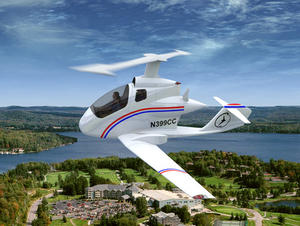Transportation in the third dimensionNew commuting method: Personal Aerial Vehicles
Researchers in Germany have an idea for solving the growing congestions in urban centers: a Personal Aerial Vehicles (PAVs) for traveling between homes and working places; the PAVs will fly at low altitude in urban environments, thus making it unnecessary to change current air-traffic control regulations

Great, as long as you don't hit traffic // Source: flightglobal.com
Road congestion in and around urban areas is a growing problem — and it will only keep growing. The solution will likely combine the best of ground-based and air-based transportation. The people at the myCopter project. Located at the Max Planck Institute for Biological Cybernetics in Tübingen, Germany, say the optimal solution would consist in creating a personal air transport system (PATS) that can overcome the environmental and financial costs associated with all of our current methods of transport.
The myCopter project proposes an integrated approach to allow the first viable PATS, which will be based on Personal Aerial Vehicles (PAVs) for traveling between homes and working places, and for flying at low altitude in urban environments. Such PAVs should be fully or partially autonomous without requiring ground-based air traffic control. Moreover, they should operate outside controlled airspace while current air traffic remains unchanged, and should later be integrated into the next generation of controlled airspace.
“The myCopter project aims to pave the way for PAVs to be used by the general public within the context of such a transport system,” the project statement says.
The project consortium consists of experts that can make the technology advancements necessary for a viable PATS, and a partner to assess the impact of the envisioned PATS on society (socio-technological evaluation). Test models of handling dynamics for potential PAVs will be designed and implemented on unmanned aerial vehicles, motion simulators, and a manned helicopter. In addition, the project will also investigate the human capability of flying a PAV, resulting in a user-centered design of a suitable human-machine interface (HMI). The project also intends to introduce new automation technologies for obstacle avoidance, path planning, and formation flying. “This project is a unique integration of technological advancements and social investigations that are necessary to move public transportation into the third dimension,” the project’s mission statement says.
“Whenever I get stuck in traffic, I think what a stupid thing [it is] to be on the road when the space above me is free — so why not use the third dimension for personal transportation?” Professor Heinrich Bülthoff of the Max Plank Institute told the Engineer. “The controlled airspace starts at 2,000ft, so there’s quite a bit of unrestricted airspace below that — which, of course, can only be used by pilots currently, but the idea is to make flying as easy as driving a car and that’s what we’re looking at.”
The Engineer notes that many problems will have to be addressed: aerospace legislation will have to be changed and infrastructure created for parking the PAVs at commuters’ workplaces, without the need for an inordinate amount of training. Energy considerations are also important — the project’s scientists have calculated that an individual electric flying vehicle, with a counter-rotating rotor, would be able to cover twenty kilometers on battery power.
